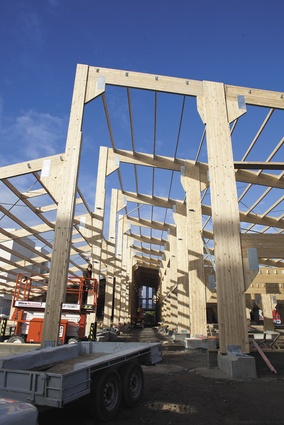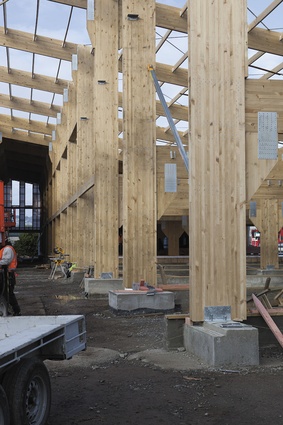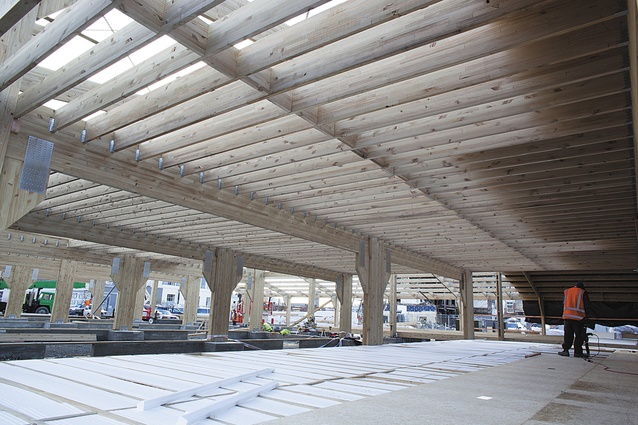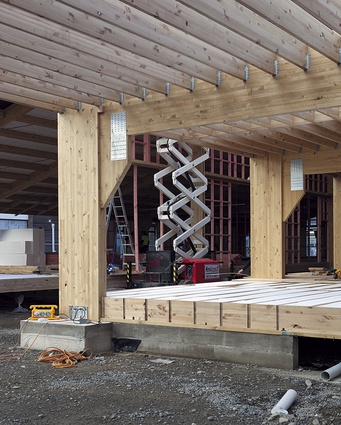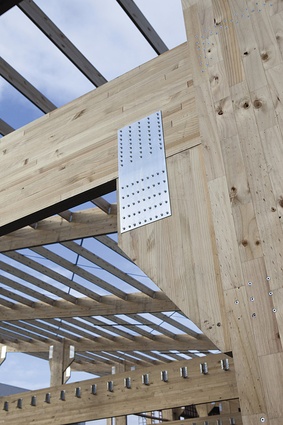Pretty cool barn
This $4 million structure has been purposefully built for a space which is available for just five years, and incorporates a barn which forms its central atrium.
The massive laminated timber beams used in the construction of Christchurch’s Enterprise Precinct and Innovation Campus (EPIC) were so impressive passers-by regularly stopped to take photographs as the building took shape.
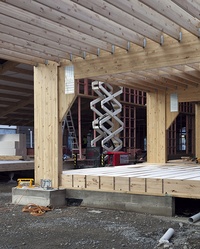
There is another less obvious, but equally impressive fact about this 3800-square-metre office block: the entire one-and-a-half-story structure built by Timbercore can be pulled apart and sold off section by section in five years’ time when rent-free use of a council-owned site on the corner of Manchester and Tuam Streets comes to an end.
The IT business group Epic Christchurch was set up with the goal of providing accommodation for IT companies displaced by the earthquakes. Director and board chair Colin Anderson says architects Warren and Mahoney came up with a preliminary design which formed the basis for the tender, and the winning bid by Timbercore had the X-factor they were seeking.
The $4 million project attracted substantial grants from the Ministry of Science and Innovation, and New Zealand Trade and Enterprise, and Anderson says they came under considerable pressure to make do with a clutch of small, prefabricated buildings which would have required duplication of resources such as power and air conditioning. “And we said, ‘You can’t sell inspiration with a bunch of prefabs.’ ”
EPIC wanted to encourage collaboration between its 17 tenants and Anderson says the big open communal lounge area in the middle of the Timbercore building will achieve that. “It’s a barn, but it’s a pretty cool barn. On the exterior the timber is covered with cladding but inside the timber is exposed with these big 12 inch wooden beams that let us create an atrium.”
But re-locatability and affordability were absolutely crucial for the venture to succeed and Timbercore was able to meet that challenge. Between them, directors Peter Roil and Kevin Barron have more than 60 years’ experience in the building industry. Roil is the owner of Kanuka Engineered Wood Products in Hastings where the glue laminated engineered timber components are manufactured, and Timbercore, headed by Barron, fabricates them on site. “It saves time on site and there’s less need for a huge amount of room to make up the frames because we have limited space here,” says Barron.
Until now Timbercore has worked mostly in rural areas, building warehouses, workshops, marae, and affordable accommodation on farms. EPIC is their first commercial office building (they can build up to four storeys high) and a further two Christchurch office blocks (two and three stories high) are in the planning stages.
For the framing 45 mm thick lengths of treated pine are laminated together with finger joints between sections, with knots removed to maximise timber usage. The pre-made portal legs stand 11 metres high and the longest beams measure 18 metres, which Barron says is getting near the limit in terms of transport. “We can go up to 23 or 24 metres without any problem, but over that you get into a bit of trouble transporting it around the country.” A big advantage of timber, says Barron, is that it weighs about four times less than steel or concrete, reducing the need for deep concrete foundations; in the EPIC building they go only 500 mm into the ground.
Timbercore normally uses nails for fixings because they are stronger and faster to work with. Compared to a steel building, labour costs are lower because the work can be done by hammer hands with no need for specialist trades such as riggers and welders. However, bolts and screws were used in the re-locatable EPIC building for ease of removal; hence plywood wall linings are screwed rather than nailed. Flooring is 20 mm composite timber because it is cheaper to remove than a concrete floor and Barron says the beauty of the timber flooring is it is that services hang under it. “We’ve left gaps in the foundations so we can crawl in and put pipes and wires in.” And again, removal is much easier. Seismic strength is a must in quake-prone Christchurch and the EPIC offices will be built to 130 per cent of the building code. Barron says beams are attached to the portal legs with wooden clip-lock joints that slot through the top of the portal and are fastened with 90 mm screws. “That’s one of the seismic benefits. If one of those screws breaks, there’s another 100 there to hold onto it, and they can be replaced. If there’s a failure it’s easy to see, and you can put another 50 in there if you want to, whereas when steel and concrete break, it’s gone.” Diagonal timber struts and 100 mm timber wall bracing panels with steel rods running vertically between the sheets also add to the building’s strength. Fire risk is often cited as a down side to building with timber, but Barron says it performs well in a blaze. “It doesn’t burn through, it chars on the outside and creates a protective layer that stays up and doesn’t give way, whereas other materials will bend and deform when they get to certain temperatures.” In fire rated areas of the building, such as on the mezzanine floor, wooden portal legs are solid timber rather than hollow. “If we left them hollow, we’d have to clad them in a plaster fire-rated lining to get the fire rating.”

EPIC’s founders were keen to have a building that was as sustainable as their limited budget and the limited lifespan of the building would allow, which was another reason to go for a timber-heavy design. Barron estimates the building required 800 cubic metres of timber (equivalent to three hectares of trees), 160 cubic metres of concrete, very little steel, and about 200,000 screws and fixings. With timber production taking a tenth of the energy required to produce steel or concrete, he believes it is a building material that will become increasingly popular as customers demand sustainable, earthquake-proof building solutions. Another plus from timber framing is that additions, extensions and alterations can be accommodated up to and during the construction phase. Anderson says this flexibility allowed them to re-orientate the building at the council’s request. “We turned it around 180 degrees so as to maximise impact of the angled roof, and it let us bring more light in.”
Plans for a 20 week build were stymied by bad weather, including snow, and Anderson says delays ironing out legal niceties over funding and site use meant they missed a scheduled timber production run, but EPIC will officially open in October.
In the blue print for the Christchurch rebuild the centre sits within a proposed innovation precinct, and Anderson hopes to find a way of retaining the building. If that fails, Timbercore will buy the structure from EPIC and take it away, a prospect that leaves Barron completely unfazed. Gesturing to one side of the building he says it could be sold off in six sections, and taking out the first floor would create a large warehouse. “If someone wanted to buy it, they could say, I want this part or that part.”

